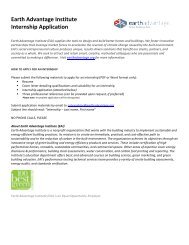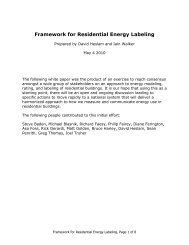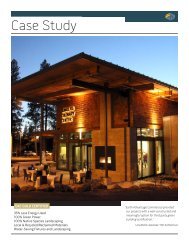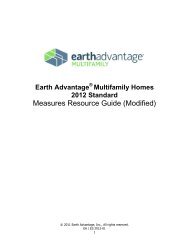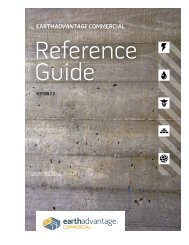EA New Homes Measures Guide - Earth Advantage
EA New Homes Measures Guide - Earth Advantage
EA New Homes Measures Guide - Earth Advantage
You also want an ePaper? Increase the reach of your titles
YUMPU automatically turns print PDFs into web optimized ePapers that Google loves.
2012 <strong>Earth</strong> <strong>Advantage</strong> Residential<br />
<strong>Measures</strong> Resource <strong>Guide</strong><br />
4.3.3<br />
Ductwork and Air Handling Equipment in Heated Space<br />
Energy<br />
Materials<br />
Water<br />
0 2 0 2 0<br />
Description: Install the air handler and all ductwork within the thermal boundary of the home. HVAC equipment must not be installed in the<br />
garage, crawlspace or attic space. Since most home designs fail to make any accommodation for ducts, it is often necessary to carefully<br />
plan where the ducts will run. Several methods can be used. Dropped soffits and thick walls can be built to hold ducts. Attics or<br />
crawlspaces can be enclosed and insulated to bring them "inside". In two story designs, open floor trusses allow tremendous flexibility for<br />
ducts. Up to 5 percent of the total duct length may extend outside the thermal boundary.<br />
Health<br />
Land<br />
Benefit: Placing ductwork within the thermal envelope eliminates heat loss and air leakage from ducts. It also prevents many of the indoor<br />
air problems associated with running ductwork in the crawl space and/or garage. Duct sealing with water-based mastic is still mandatory.<br />
Verification: <strong>EA</strong> Rater will verify that all ducts are inside the conditioned space and are sealed with mastic paste. A duct test (leakage to<br />
outside) may also be required if the home is trying to qualify for the Federal Tax Credit.<br />
4.3.4<br />
Air Balancing Forced Air System: Performance Test<br />
Energy<br />
Materials<br />
Water<br />
0 2 0 0 0<br />
Description: Have the total supply air flow rates and temperatures in each room tested using a flow hood with doors closed. The flow rates<br />
should match Manual J system sizing provided by the HVAC contractor.<br />
Health<br />
Land<br />
Benefit: Third-party testing of the HVAC distribution air flows can identify problems with the design and installation of the air distribution<br />
system. These problems can surface after the installation of the distribution system such as ducts that are blocked, crushed, or punctured<br />
by other trades during the construction of the home. An ineffective distribution system can reduce comfort and waste energy.<br />
Verification: <strong>EA</strong> Rater will verify the following: Supply air flow rates must be within +/- 15% (or +/- 10cfm) of calculated values from ACCA<br />
Manual J. Multi-speed HVAC systems will be tested at full capacity. Supply air flow requirements must meet the higher of the cooling or<br />
heating designed air flow for each room. Set to heating mode, measured cfm at each register, report results to general contractor. Ductless<br />
systems qualify for this credit if sized to the actual heating load.<br />
4.3.5<br />
Energy Health Land Materials Water<br />
Protect Duct Vents: Cover supply boots in floor during construction and<br />
Prerequisite<br />
install temporary filter on cold return<br />
Description: Cover supply register boots in the floors and ceilings during construction with a durable material that will prevent dirt, dust or<br />
construction debris from entering the duct system. Floor covers must be rigid enough to support construction activity. In addition, a<br />
temporary filter must be installed on the cold air return grille to keep debris and small particles from entering the ducting system. This<br />
measure is required of all <strong>Earth</strong> <strong>Advantage</strong> projects that utilize a ducted system for heating and cooling air distribution.<br />
Benefit: Duct vents and returns can collect a lot of dust, dirt, and construction debris. Covering the vents and returns during construction<br />
protects the HVAC equipment and improves the indoor air quality.<br />
Verification: <strong>EA</strong> Rater will confirm that supply registers in the floor are covered and that a temporary filter is placed over the cold return<br />
opening.<br />
Page 35 of 70



